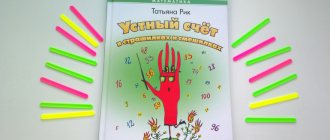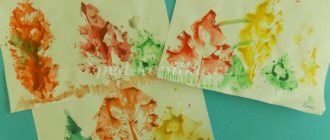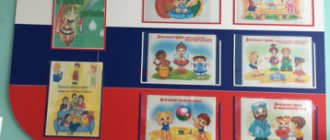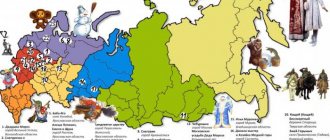Lapbook “My Family”
Author:
Musina Zimfira Sayfullovna
teacher
MBDOU kindergarten "Snezhinka"
Khanty-Mansi Autonomous Okrug, Surgut district
At early preschool age, children begin to form elementary ideas about the phenomena of social life and the norms of human communication[1]. Children of this age are characterized by great emotional responsiveness, which allows them to cultivate love, good feelings and relationships towards people around them and, above all, towards loved ones, towards their family. This is the basis of moral and patriotic education[2].
This year I decided to create a lapbook “My Family”, in which the children’s parents actively took part.
The purpose of my work is to introduce children to family members, their hobbies, family traditions and values, and relationships in their lives.
Tasks:
— expand the idea of the family through the organization of different types of activities;
- cultivate love and respect for family members;
- introducing the child to the nearest society - getting to know the family, the history of the family, and the traditions of the family.
The laptop is a homemade interactive thematic folder, with pockets and games according to age.
Figure 1 shows my finished work.
Each game is divided into pockets:
— Didactic games: “Story pictures”, “Cut-out pictures”, “Granny’s rug”, “Family portrait”, “Assemble a house”;
- finger games.
Also, children and their parents took an active part in creating the family tree and photo album “Family”
Such an unusual, bright, colorful, entertaining and accessible folder will definitely attract the attention of children and parents. What will contribute to the development of memory, attention, observation and bringing the family closer to joint creative activity.
BIBLIOGRAPHY
1. Bure R.S. Toolkit. Social and moral education of preschool children (3-7 years old), 2016.
2. Veraksa N.E., Komarova T.S., Vasilyeva M.A. Basic educational program of preschool education “From birth to school”, Moscow-2016.
“Certificate of publication in the media” Series A No. 0004990
We invite teachers of preschool education in the Tyumen region, Yamal-Nenets Autonomous Okrug and Khanty-Mansi Autonomous Okrug-Yugra to publish their teaching materials: - Pedagogical experience, original programs, teaching aids, presentations for classes, electronic games; — Personally developed notes and scenarios of educational activities, projects, master classes (including videos), forms of work with families and teachers.
Why is it profitable to publish with us?
1. “Kindergartens of the Tyumen Region” is an officially registered specialized media outlet at the federal level. 2. The activities of the editorial office are supported by the Department of Education and Science of the Tyumen Region 3. We issue a “Certificate of Publication” in the media. 4. The document has a unique number, is entered in the register, has the original seal of the editorial office of the online publication and signature. 5. “Certificate of publication” in the media is sent to the author in both paper and electronic versions.
Details >>>
Sample “Certificate of publication of author’s methodological material in the media.”pdf
Share
Methodological recommendations for using the developmental didactic manual lapbook “My Family”
Relevance of the manual
At preschool age, the formation of cultural and value orientations, the spiritual and moral basis of the child’s personality takes place, the development of his emotions, feelings, thinking, mechanisms of social adaptation in society, and the process of self-awareness in the world around him begins.
This period in a person’s life is the most favorable for emotional and psychological impact, since the images of perception of reality are very vivid and strong and therefore they remain in memory for a long time, and sometimes for a lifetime.
The family is of great importance in solving these problems. After all, family values are the principles on which our lives are based; they are the standards by which we judge what is right and what is wrong. It is in the family that a child develops a sense of love and affection for his home, family, family traditions and customs. Unfortunately, the diagnostic results show that children do not have clear ideas about the concepts of “family”, “family members”, about the family tree, and have poorly formed ideas about the professions of their parents and the importance of these professions in society. Many children cannot describe the importance of family for a person. Parents also underestimate the importance of family traditions in raising their children. The need to create a methodological manual “My Family” was due to the above factors.
Didactic manual lapbook “My Family” is made in the form of a house, with opening doors. Inside the house there are pockets in which there are games on the theme “family”. All pockets are easily removable and can be used with different subgroups of children.
The didactic manual is designed for children aged 3 to 7 years. is a means of developing children's education. This manual helps the child choose a game at will in order to better understand and remember the material.
Expected result from using this teaching aid in the preschool education system:
- children learn more about their family: about family members, traditions, about the life of grandparents;
- children will learn to maintain a conversation and express their point of view;
— successful interaction will be established between teachers and parents, which will allow each other to provide the necessary support in the development and upbringing of the child.
The positive aspect is:
— individuality in work;
— simultaneous coverage of children from one to five children;
- can be used in different types of activities;
- mobile;
- is a striking attribute in a subject-development environment.
Goal : developing an idea of a family as people who live together, hobbies, family values; developing a sense of pride in one’s family and a desire to care for loved ones in the family.
The didactic manual allows you to solve problems:
Educational:
— expand children’s understanding of the concept of “Family” through games and various activities;
— to form ideas about morality and spiritual development of the individual through family values;
— develop skills of cooperation and mutual understanding;
- develop creative and cognitive activity through the joint work of an adult and a child.
Educational:
- develop speech activity in children, introduce the following concepts into the active vocabulary: “family, relatives, close ones”, encourage reasoning;
- develop fine motor skills;
- develop emotional responsiveness.
Educational:
— cultivate love and respect for family members;
— create an atmosphere of mutual understanding, common interests, and emotional support.
— increase the active participation of parents in the life of the group.
This manual can be used in working with children in the following educational areas:
— cognitive development;
- speech development;
— social and communicative development;
- artistic and aesthetic development.
The “My Family” lapbook includes the following games:
Didactic game “How I grow”
Goal : to teach children to determine the gender of the person depicted in the picture; Expand words knowledge; develop thinking.
Game description
Invite the child to look at three pictures, name who is drawn (girl, aunt - mother, grandmother). Ask the child who is younger and who is older.
Encourage your child to answer in complete sentences. When first introducing the game, help your child put the pictures in order, and then encourage the child to act independently or with a little help.
Using these pictures, you can offer children the following tasks:
“Who is the odd one out: boy, aunt, grandfather, uncle.” Combine pictures according to a given criterion: girls - boys, adults - children.
Didactic game “My Family”
Goal : consolidate knowledge about close relatives who live in the same apartment.
Description of the game . The game is a set of figures of family members of different genders and ages. Children are invited to place family members who live in the same apartment or house and talk about them. You can count how many people are in your family, whether there are more men or women, and you can also sort family members by age, etc.
Word game “Make a sentence”
Goal : develop attention, thinking, expand the child’s vocabulary and horizons.
Description of the game.
The envelope contains story pictures on the topic “Family”. The teacher hands out pictures to the children, asks them to carefully look at the picture and make a sentence (for younger children). At an older age, children take story pictures and make up a story based on them.
Didactic game “Who is doing what?”
Goal : to consolidate children's understanding that in the family each member has his own responsibilities, which depend on age, interests and needs.
Rules for conducting a didactic game:
1. Number of participants from 2 to 6 children.
2. Pictures are selected by each player in turn.
3. The choice of picture is accompanied by an explanation of why this particular family member should perform certain duties.
4. In one move, the child can take only one picture.
Game description
Distribute pictures depicting family members among the players. Children are asked to select tools for each family member, explain what can be done with them, for what purpose: who else can do this work.
Everyone who selected the most pictures and gave a meaningful explanation won.
Family Tree Game
Goal: to consolidate knowledge about yourself, about your family tree, pedigree, to expand your understanding of family, to learn how to navigate family relationships.
Game description
The child is asked to place family members on the tree, tell them their names, who is related to whom.
Game “Whose things are these?”
Goal: The ability to distinguish between things that belong to adults and children.
Tasks:
Educational: Form a grammatical structure through mastery of the morphological structure of speech and word formation. Exercise children in the formation of possessive adjectives. Explain the meaning of the generalized word family.
Developmental: Develop dialogical speech, memory, thinking.
Educational : Foster mutual assistance to each other.
Materials and equipment: pictures depicting family members: mother, father, children (girls and boys), grandparents are glued to clothespins. Pictures of household items: clothes, dishes, toys, school supplies, etc. are placed on a circle.
Game description
Children are given circles with images of objects. Children need to place a family member who owns these things next to each one. The child must explain why he made this choice. The one who completes the task faster wins.
LEPBUK “My Family” teaching aid (middle group) on the topic
Like all teachers, I am now in search of new forms of organizing educational activities. During the search process, I noticed the use of lapbook creation techniques. This form of work is attractive to me because it is an excellent way to repeat the material covered, the opportunity to organize work on a specific topic, taking into account comprehensive thematic planning.
The laptop is a real find for me when organizing the educational process aimed at implementing the tasks of ethnocultural practice of the variable part of the development and education program in a preschool educational institution. Lapbooks are mainly used by teachers for children of older preschool age. I decided to offer ready-made lapbooks to children of the primary and secondary groups.
One of these lapbooks is “My Family”.
Goal: Continue to form ideas about yourself and your family. Cultivate love and respect for adults.
In the “My Family” lapbook, children are offered tasks in the form of compact didactic games, entertaining pockets with tasks, games that develop fine motor skills, surprise tasks that promote the development of speech, attention, memory, and cognitive interest of children. A laptop is a transformable, multifunctional and variable aid.
The “My Family” laptop is presented in the form of a folding folder of five pages. Each page helps organize an activity with one child or a subgroup of children.
Types of activities that can be organized using this laptop:
Conversations: “My family”
"My grandmother and grandfather"
“My family works”
"Family holidays"
"Who's doing what"
Story on the topic: “Our friendly family”
“Tell me about your family members” (use of reference diagrams, models)
Didactic games: “Who needs what?”
“Show toys, dishes, clothes”
"Necessary Helpers"
"Help Mom"
“Choose dishes for lunch”
“What are we having for lunch?”
Cognitive - research activities - solving problem situations: “Grandma got sick”
“How can I help my mom, dad, brother?”
Reading fiction: a collection of poems about family members. Mini books: Fairy tales “Geese and Swans”, “The Wolf and the Seven Little Goats”
Game library: card index of finger games
algorithms for designing from building materials
When organizing joint activities using a lapbook, conditions are created to support children's initiative, and it becomes possible to individualize the educational process.






